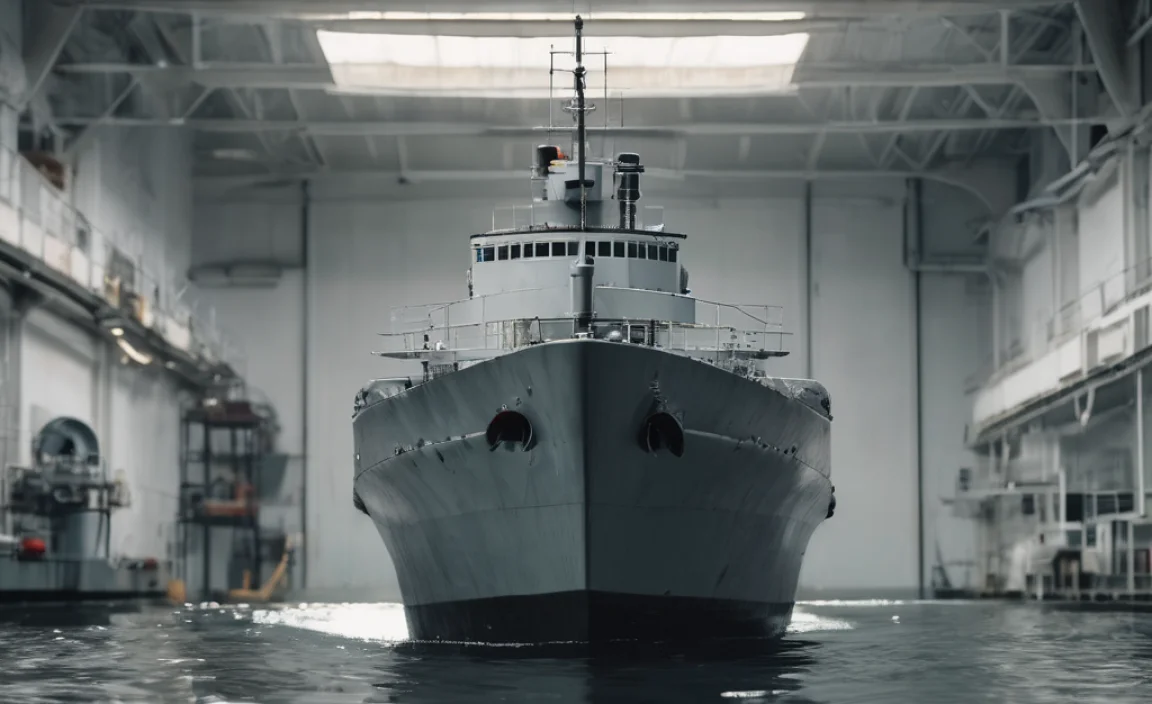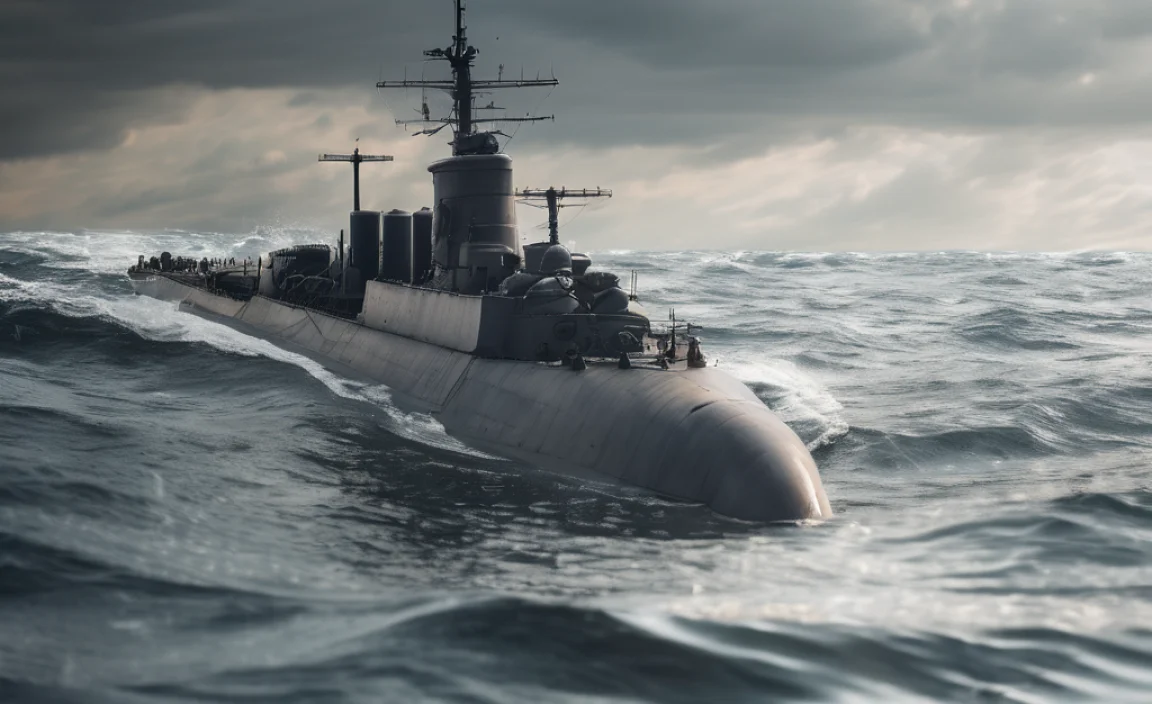The German battleship Bismarck sank on May 27, 1941, in the North Atlantic Ocean. After a fierce battle with the British Royal Navy, it succumbed to heavy damage and was scuttled by its crew to prevent capture. The sinking marked a significant victory for the Allies during World War II.
Ever wondered about the fate of the mighty Bismarck? This German battleship was a symbol of naval power during World War II. Its story is full of dramatic battles and a desperate fight for survival. It can be a bit confusing to keep track of all the details, but don’t worry! This guide will walk you through the key events that led to its sinking. We’ll break it down step by step, so you can easily understand what happened. Let’s dive in and uncover the story of the Bismarck.
The Bismarck’s Maiden Voyage

The Bismarck’s story starts with its launch and entry into service. This massive battleship was designed to be a formidable force on the high seas.
Construction and Launch
The Bismarck was built at the Blohm & Voss shipyard in Hamburg, Germany. Construction began in July 1936, and it was launched on February 14, 1939. The ship was named after the German Chancellor Otto von Bismarck. Its design incorporated the latest in naval technology at the time, making it one of the most advanced battleships in the world.
Commissioning and Early Operations
The Bismarck was officially commissioned into the German Navy on August 24, 1940. After undergoing sea trials and training exercises, it was ready for its first major operation. Its initial mission was to break out into the Atlantic Ocean and attack Allied shipping lanes. This was a critical part of Germany’s strategy to disrupt the supply lines that were vital to the British war effort.
The Fateful Mission: Operation Rheinübung

Operation Rheinübung was the Bismarck’s first and only major combat mission. It aimed to disrupt Allied shipping in the Atlantic, but it quickly turned into a desperate battle for survival.
The Voyage Begins
On May 18, 1941, the Bismarck, accompanied by the heavy cruiser Prinz Eugen, set sail from Gotenhafen (now Gdynia, Poland). Their mission was to break through the British blockade and attack merchant ships in the Atlantic. The two ships sailed north through the Kattegat and into the North Sea. Their goal was to reach the open waters of the Atlantic, where they could inflict maximum damage on Allied shipping.
Encounter with HMS Hood and Prince of Wales
On May 24, 1941, the Bismarck and Prinz Eugen encountered the British battlecruiser HMS Hood and the battleship Prince of Wales in the Denmark Strait. A fierce battle ensued. The Hood, a symbol of British naval power, was struck by several shells from the Bismarck and exploded, sinking rapidly with almost all hands. The Prince of Wales was also damaged but managed to escape. This victory was a major propaganda coup for Germany, but it also made the Bismarck a prime target for the Royal Navy.
Here’s a table summarizing the key ships involved in the battle:
| Ship Name | Type | Nation | Fate |
|---|---|---|---|
| Bismarck | Battleship | Germany | Sunk |
| Prinz Eugen | Heavy Cruiser | Germany | Survived the battle |
| HMS Hood | Battlecruiser | United Kingdom | Sunk |
| Prince of Wales | Battleship | United Kingdom | Damaged, but survived |
Pursuit by the Royal Navy
Following the sinking of the Hood, the Royal Navy launched a massive pursuit of the Bismarck. Numerous British warships were dispatched to hunt down and destroy the German battleship. The Bismarck, now with a damaged fuel tank from the battle with the Prince of Wales, headed towards France for repairs. The Royal Navy was determined to prevent this.
The Final Battle and Sinking

The final days of the Bismarck were marked by relentless pursuit and a desperate fight for survival against overwhelming odds.
Torpedo Attack by Fairey Swordfish
On May 26, 1941, Fairey Swordfish biplanes from the aircraft carrier HMS Ark Royal launched a torpedo attack on the Bismarck. One of the torpedoes struck the Bismarck’s steering gear, causing irreparable damage. This left the Bismarck unable to steer effectively, sealing its fate. The Swordfish, though outdated, proved to be instrumental in crippling the Bismarck.
The Final Confrontation
On the morning of May 27, 1941, the battleships HMS Rodney and HMS King George V engaged the Bismarck in a final, decisive battle. The British ships pounded the Bismarck with heavy gunfire, inflicting massive damage. The Bismarck fought back valiantly, but it was no match for the combined firepower of the British battleships. The Bismarck was also attacked by the heavy cruisers HMS Dorsetshire and HMS Norfolk.
Scuttling and Sinking
After enduring relentless bombardment, the Bismarck was heavily damaged and ablaze. To prevent the ship from falling into enemy hands, the surviving crew members scuttled the ship. Scuttling involves opening valves to flood the ship, causing it to sink. The Bismarck finally sank at approximately 10:40 AM on May 27, 1941. Only 115 of the more than 2,200 crew members survived. The sinking of the Bismarck was a major victory for the Allies and a significant blow to the German Navy.
Here’s a timeline of the key events leading to the sinking of the Bismarck:
- May 18, 1941: Bismarck sets sail from Gotenhafen.
- May 24, 1941: Battle of the Denmark Strait; HMS Hood is sunk.
- May 26, 1941: Torpedo attack by Fairey Swordfish damages Bismarck’s steering.
- May 27, 1941: Final battle and sinking of the Bismarck.
Aftermath and Significance
The sinking of the Bismarck had a profound impact on the course of World War II and continues to be a subject of historical interest.
Impact on the War
The sinking of the Bismarck had a significant impact on the naval balance of power in the Atlantic. It demonstrated the vulnerability of even the most powerful battleships to air power and determined pursuit. The loss of the Bismarck forced the German Navy to reconsider its surface raiding strategy, reducing the threat to Allied shipping lanes. This allowed the Allies to maintain vital supply lines, which were crucial for the war effort. The Bismarck’s sinking boosted Allied morale and served as a symbol of British determination.
Discovery of the Wreck
The wreck of the Bismarck was discovered on June 8, 1989, by Dr. Robert Ballard, the same oceanographer who discovered the wreck of the Titanic. The wreck lies at a depth of approximately 4,791 meters (15,718 feet) in the Atlantic Ocean, about 650 kilometers (400 miles) west of Brest, France. The discovery provided valuable insights into the ship’s final moments and confirmed the accuracy of historical accounts. The wreck is now a protected site, serving as a memorial to the crew who lost their lives.
Lessons Learned
The story of the Bismarck offers several important lessons in naval warfare and strategy:
- The importance of air power: The torpedo attack by the Fairey Swordfish biplanes demonstrated the vulnerability of battleships to air attacks.
- The significance of naval intelligence: The Royal Navy’s relentless pursuit of the Bismarck was made possible by effective intelligence gathering and codebreaking.
- The impact of technological advancements: The Bismarck’s design and technology were state-of-the-art for its time, but it was ultimately outmatched by the combined forces of the Royal Navy.
FAQ: Frequently Asked Questions
Here are some common questions about the Bismarck and its sinking, answered simply.
When was the Bismarck sunk?
The Bismarck was sunk on May 27, 1941.
Where did the Bismarck sink?
The Bismarck sank in the North Atlantic Ocean, about 400 miles west of Brest, France.
Who sank the Bismarck?
The Bismarck was sunk by a combination of British warships, including HMS Rodney, HMS King George V, HMS Dorsetshire and HMS Norfolk. The final blow was the scuttling of the ship by its own crew.
Why was the Bismarck so feared?
The Bismarck was one of the largest and most powerful battleships of its time, representing a significant threat to Allied shipping.
How many people survived the sinking of the Bismarck?
Only 115 of the more than 2,200 crew members survived the sinking.
What was the Bismarck’s mission?
The Bismarck’s mission, Operation Rheinübung, was to disrupt Allied shipping in the Atlantic Ocean.
How was the wreck of the Bismarck discovered?
The wreck of the Bismarck was discovered by Dr. Robert Ballard in 1989, using advanced sonar and underwater exploration technology.
Conclusion
The sinking of the Bismarck is a dramatic and pivotal event in naval history. On May 27, 1941, this mighty battleship met its end in the North Atlantic, after a relentless pursuit by the British Royal Navy. The Bismarck’s story highlights the crucial role of naval warfare during World War II and the impact of technological advancements on military strategy. From its impressive construction to its final battle, the Bismarck remains a subject of fascination and study. Understanding its history provides valuable insights into the complexities of maritime conflict and the sacrifices made by those who served at sea. Next time you hear about naval history, you’ll have a clearer picture of the Bismarck’s place in it. Keep exploring and learning!


